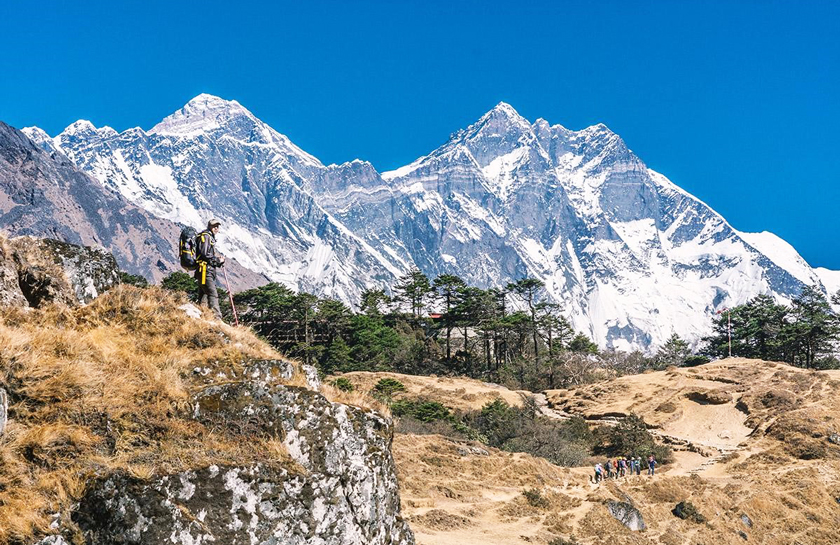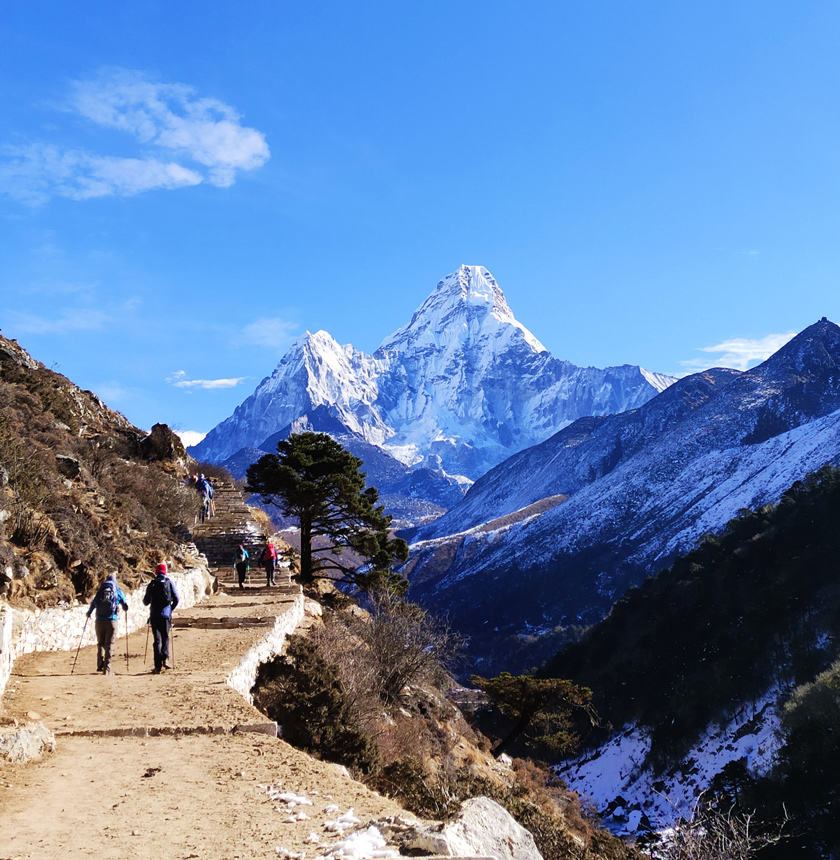Everest Base Camp weather- Best seasons to hike

Many travelers planning to hike Everest Base Camp (EBC) are not sure about the best time to go. We get questions like – when to go to EBC?, what is the weather and temperature like in the Everest region? and several others on our email and travel forums. Taking this into consideration, in this blog, we are addressing everything you need to know about the weather conditions of various seasons in the Everest region.
When deciding the best time to hike to EBC, first and foremost it depends on your preference. So, it can be done in all seasons all year around because each month has something unique to offer to visitors rather than waiting for the popular peak seasons, spring and autumn.
Certain months March-April and October-November cross some of the biggest highlights of Everest region with astonishing mountain views. And to be fair, you will find various natural and cultural attractions such as diverse flora and fauna, festivals offering some of the most beautiful scenery all year round in the Everest region.
Let’s dive deeper.
Everest Base Camp Trek in Spring (March, April)
Spring is the favored season to hike EBC partly due to its incredible mountain views and partly due to warm weather and blooming alpine flowers. As April/May happens to be the most preferred time for Everest summit, spring is a little bit crowded with hikers and mountaineers preparing for Everest expeditions. It is possible to see climbers staying in a tented camp on the highest base camp on the planet during this time.
Weather: The spring months are a little bit warmer along with clear skies and increase in precipitation. Also, sometimes there are chances of thunderstorms, followed by sporadic rain and hailstones during this time.
Average temperature: 17 degrees centigrade (above 4,000 m)
Daytime temperature: 25 degrees centigrade
Night-time temperature: -15 degrees centigrade
Major attractions: Spring is rejuvenated and colorful as mother nature is full of wildlife activities with chirping birds and blooming flowers. You can see flowers like rhododendrons, primroses and irises on this constantly changing trail. Also, this is the perfect time to see birds like Himalayan Monal, Tibetan Snowcock and many more as they come to breed in high altitude regions.
Besides, the major cultural attraction is Buddha Jayanti, a major festival of Buddhist if you happen to be in the Everest region during this time.
Hiking tips: Make sure you wear waterproof boots, pack warm layer clothes and rainwears for the trek.
Everest Base Camp Trek in Summer (May, June)
This time is not a popular option for hikers, but the region quickly fills with mountaineers as April/May is the best time for summiting Everest. Likewise, the world’s highest running event “Everest Marathon” was held on May 29 every year which is the best time to visit for trail runners. Unlike peak seasons spring and autumn, trekking on this time is suitable for nature lovers to get away from crowds and enjoy the natural beauty of diverse flora and fauna.
Weather: This time is marked with sunny days, cloudy skies and slightly increase in precipitation. The morning is usually hot and sunny whereas it gets rainy in the afternoon.
Average temperature: 15 degrees centigrade (above 4,000 m)
Daytime temperature: 30 degrees centigrade
Night-time temperature: 2 degrees centigrade
Major attractions: It’s high impact biodiversity in Everest region where you will find all varieties of colorful rhododendron flowers and various kinds of birds like cuckoos, nutcrackers, redstarts, laughing thrushes and many more.
This time is best to attend the annual Sherpa festival – Mani Rimdu celebrated in early June.
May 29 is Everest day, where the most popular Everest marathon is organized every year for the celebration of the first successful ascent of Mount Everest.
Hiking tips: Pack sunscreen to protect from UV along with sunglasses and rainwears. Also, include 2-3 extra days as there is likely to be flight disruptions at Lukla.
Everest Base Camp Trek in Monsoon (July, August)
Most trekkers avoid hiking in the monsoon as there is increased rainfall in the Everest region. However, some adventurers hike during this time to see alpine flowers, and jaw dropping scenery of waterfalls and raging rivers.
Weather: These months start with a high precipitation, and the mornings are usually clear and dry. The days are noticeable for warm temperature, high humidity, and heavy downpour.
Average temperature: 18 degrees centigrade (above 4,000 m)
Daytime temperature: 25 degrees centigrade
Night-time temperature: -15 degrees centigrade
Major attractions: The trail is full of immense green scenery with open meadows, flowers and pine forests.
On top of that, there is a celebration of Dumji festival (usually in the month of June/July) which makes the trek worthwhile to get acquainted with Sherpa culture and their faiths.
Hiking tips: Bring rainwears and waterproof hiking boots. Due to frequent rainfall, there is a possibility of flight cancellations, so make sure you include 2-3 extra days for the trek.
Everest Base Camp Trek in Autumn (September, October)
Unlike other seasons, the trails are crowded during autumn/fall as it is the most preferred season among trekkers to hike Everest Base Camp. This time is great for mountain views as the sky is clear, and you can look out for everything from magnificent Himalayas to stunning landscapes of Everest region. When it comes to scenery, there are plenty of views you don’t want to miss out along the journey.
Weather: This hike is so popular in autumn due to it’s pleasant weather and temperature. Also, the monsoon rain has cleared the sky offering an amazing visibility for mountain views.
Average temperature: 15 degrees centigrade (above 4,000 m)
Daytime temperature: 20 degrees centigrade
Night-time temperature: -10 degrees centigrade
Major attractions: Indeed, it’s high impact scenery and magnificent mountain views that makes this hike worthwhile during autumn. Along the high alpine route, you will find varieties of flowers, birds, wildlife and their awesome views.
Besides, the popular Mani Rimdu Festival of Tengboche is celebrated in late October in some of the years. If you are lucky enough to be around this time, make sure you attend this one.
Hiking tips: Everest region is quickly filled with trekkers during autumn, so make sure you plan your trip from a trekking agency as they help you arrange flights and accommodation in advance. Make sure you bring all the trekking equipment required for the trek.
Everest Base Camp in Pre- winter (November, December)

November/December is pre winter months in Nepal so these months also remained popular among hikers.
Weather: The months of November/December are usually drier with clear skies offering stunning mountain views. With low temperatures and minimum precipitation, trekking to EBC can be enjoyable for many hikers during this time.
Average temperature: 10 degrees centigrade (above 4,000 m)
Daytime temperature: 17 degrees centigrade
Night-time temperature: -16 degrees centigrade
Major attractions: There are plenty of rewarding views, especially wildlife and birds along the way. In winter, enjoy the views of Musk deer, Himalayan Monal and Himalayan Thar in the trail as they made their way down to lower altitude regions during winter.
If you happen to hike around early November, don’t miss out the Mani Rimdu festival at Tengboche.
Hiking tips: The UV radiation is high this time so make sure you pack good sunscreen and sunglasses for the trek.
Everest Base Camp in Winter (January February)
The months of January/February are the least visited by trekkers in Everest region due to the increasing cold temperature in higher elevation. However, if you are willing to brave the cold, you can have a completely different experience of magnificent mountain views.
Weather: The temperature declines gradually with frequent snowfall in the month of January/February. Though the nights are extremely cold, the day temperature is bearable on the trails. The clear skies during this time can be a rewarding experience for trekkers to enjoy magnificent mountain views.
Average temperature: -4 degrees centigrade (above 4,000 m)
Daytime temperature: 6 degrees centigrade
Night-time temperature: -20 degrees centigrade
Major attractions: The mountain views are spectacular and Gokyo lakes are frozen at this time.
You will see various wildlifes and birds of Everest region en route as they descend to lower valleys during the winter season.
Likewise, the Sherpas people celebrate New Year, Gyalpo Losar at the end of February. So, don’t miss the colorful festival of Sherpa people of Everest region en route.
Hiking tips: Wear warm clothes with warm layers that include a good down jacket and hiking boots. As UV exposure is high during winter, make sure you wear good quality sunscreen and good sunglasses.
To conclude, it is worthwhile to hike to Everest region through the year as the various months are suitable for various reasons like mountain views, festivals, watching wildlife, flowers, birds, perfect weather, less crowds to name a few. So, in a lot of ways, you can consider your priorities to decide the best month to trek to EBC.
For more information, you can contact us or visit our website. We, Trekking to Nepal, can help you to plan Everest Base Camp Trek and make a memorable journey to Everest region.
